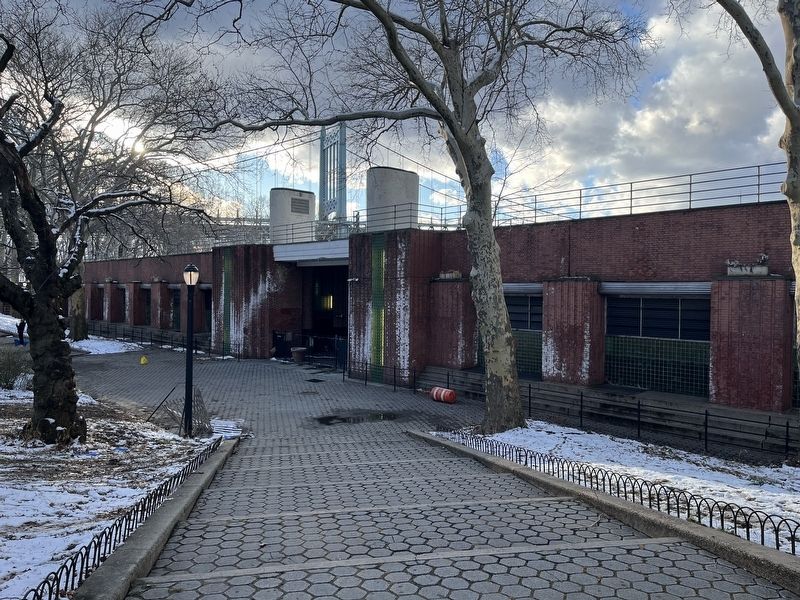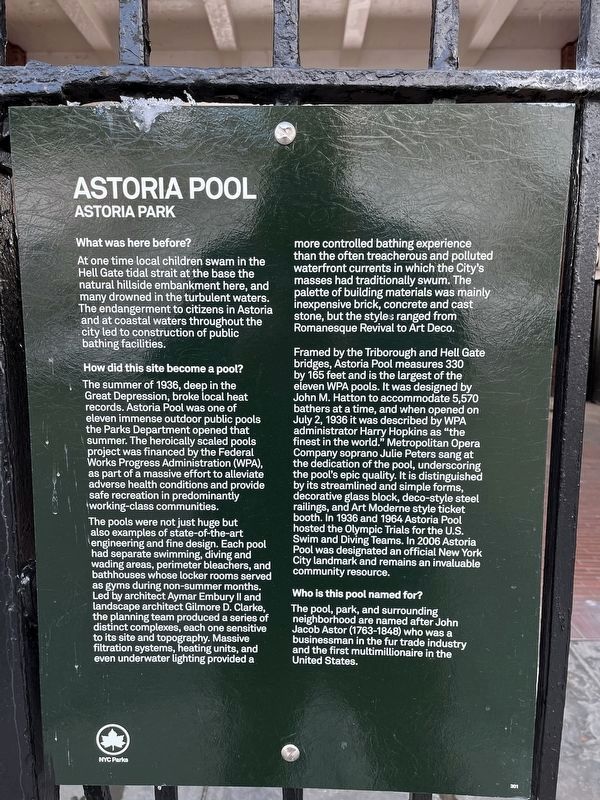Astoria in Queens in Queens County, New York — The American Northeast (Mid-Atlantic)
Astoria Pool
Astoria Park
What was here before?
At one time local children swam in the Hell Gate tidal strait at the base the natural hillside embankment in the turbulent waters. The endangerment to citizens in Astoria and to coastal waters throughout the city led to construction of public bathing facilities.
How did this site become a pool?
The summer of 1936, deep in the Great Depression, broke local heat records. Astoria Pool was one of eleven immense outdoor public pools the Parks Department opened that summer. The heroically scaled pools project was financed by the Federal Works Progress Administration (WPA), as a part of a massive effort to alleviate adverse health conditions and provide safe recreation in predominantly working-class communities.
The pools were not just huge but also examples of state-of-the-art engineering and fine design. Each pool had separate swimming, diving and wading areas, perimeter bleachers, and bathhouses whose locker rooms served as gyms during non-summer months. Led by architect Aymar Embury II and landscape architect Gilmore D. Clarke, the planning team produced a series of distinct complexes, each one sensitive to its site and topography. Massive filtration systems, heating units, and even underwater lighting provided a more controlled bathing experience than the often treacherous and polluted waterfront currents in which the City's masses had traditionally swum. The palette of building materials was mainly inexpensive brick, concrete and cast stone, but the styles ranged from Romanesque Revival to Art Deco.
Framed by the Triborough and Hell Gate bridges, Astoria Pool measures 330 by 165 feet and is the largest of the eleven WPA pools. It was designed by John M. Hatton to accommodate 5,570 bathers at a time, and when opened on July 2, 1936 it was described by WPA administrator Harry Hopkins as "the finest in the world." Metropolitan Opera Company soprano Julie Peters sang at the dedication of the pool, underscoring the pool's epic quality. It is distinguished by its streamlined and simple forms, decorative glass block, deco-style steel railings, and Art Moderne style ticket booth. In 1936 and 1964 Astoria Pool hosted the Olympic Trials for the U.S. Swim and Diving Teams. In 2006 Astoria Pool was designated an official New York City landmark and remains an invaluable community resource.
Who is this pool named for?
The pool, park, and surrounding neighborhood are named after John Jacob Astor (1763-1848) who was a businessman in the fur trade industry and the first multimillionaire in the United States.
Erected by NYC Parks. (Marker Number 301.)
Topics and series. This historical

Photographed By Devry Becker Jones (CC0), February 17, 2024
2. Astoria Pool inside Astoria Park
The marker hangs on the fence to the pool.
Location. 40° 46.708′ N, 73° 55.318′ W. Marker is in Queens, New York, in Queens County. It is in Astoria. Marker is on 19th Street south of 23rd Drive, on the right when traveling south. Touch for map. Marker is at or near this postal address: 57 19th St, Astoria NY 11105, United States of America. Touch for directions.
Other nearby markers. At least 8 other markers are within walking distance of this marker. World War I Memorial (about 500 feet away, measured in a direct line); General Slocum Disaster (about 600 feet away); New York Connecting Railroad (approx. ¼ mile away); Peter Chappetto Memorial Square (approx. ¼ mile away); Flight 587 Memorial Grove (approx. ¼ mile away); Sophocles (approx. ¾ mile away); Lawrence Family Graveyard (approx. 0.9 miles away); Welcome to the Freshwater Kills (approx. one mile away). Touch for a list and map of all markers in Queens.
Credits. This page was last revised on February 22, 2024. It was originally submitted on February 22, 2024, by Devry Becker Jones of Washington, District of Columbia. This page has been viewed 42 times since then. Photos: 1, 2. submitted on February 22, 2024, by Devry Becker Jones of Washington, District of Columbia.
